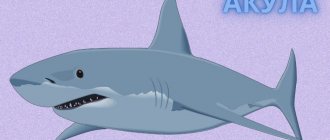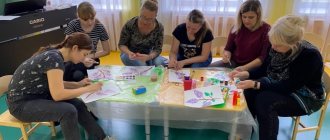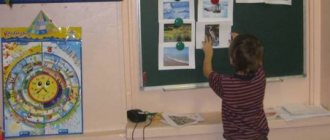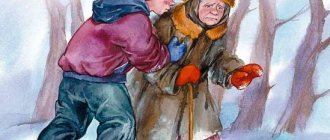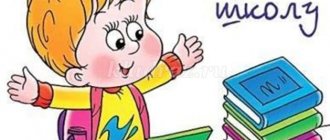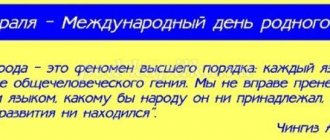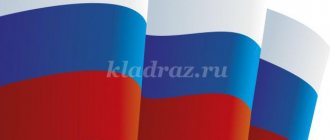Lesson notes - excursions for kindergarten
A series of activities - excursions for preschoolers around the mini-museum “The Book is the Best Friend”
In our kindergarten, much attention is paid to instilling in children an interest in books. A mini-museum is preparing to open this year: “A Book is a Best Friend” is a product of a long-term project: “A Book is a Window to the World.” I bring to your attention a series of activities in the form of excursions, where children will learn the history of the appearance of books from their favorite hero Luntik, examine fountain pens, an inkwell, birch bark, stones, leather, and try to write with a quill pen and impressions. “Excursions” widely use ICT, which makes the learning process interesting, visual and accessible to preschoolers. Children independently draw their own conclusions about which books are convenient to store and use.
Excursion 1. Sightseeing tour.
Target.
Introduce the mini-museum; variety of books (by shape, volume, binding, purpose); draw attention to books; create a desire to read; develop cognitive and speech abilities, the ability to answer and ask questions, recognize a work from a fragment; enrich the vocabulary (museum, excursion, encyclopedia). Expositions. “Books of grandmothers”, “Books of parents”, “Modern books”. Material. Books for gifts. Course of the excursion: Luntik.
Today is our special day! I will introduce you, friends, to an object without which we cannot live in the world! Now I will tell you a riddle, and you will try to guess it. It is made of plain paper. There are icons on the pages: dots, hooks. And most importantly, there are mysterious signs - letters. When we read, that is, we put syllables and words together, amazing adventures come to life before us. People unfamiliar to you communicate with you, tell you something, invite you to places you have never been before. Guess what it is? Children. Book! Luntik. That's right, it's a book. Why do we need books? (Answers) We need books to read, learn new things, study at school and be smarter. Well done! They answered my question correctly. For this I will tell you a big secret. Today we will go to the mini-museum of the book, which opened in our group. How do you think. What does "mini-museum" mean? (Answers.) That's right, it means “small museum.” Our city has large museums with many different exhibits. Why can't we open a big museum in the group? Children. Not enough space. A large museum would not fit! Luntik. That's right, but there's enough space for a mini-museum. It contains quite a few different books. Look here (shows the encyclopedia). What is this book? Who knows what it's called? (Answers.) Yes, this is a large encyclopedia for preschoolers, in which you can read information on various topics. There are encyclopedias for adults that are devoted to specific topics, such as history, biology, medicine, etc., and this encyclopedia contains interesting information for children on every page. Did you know that your grandmothers also loved to watch and read books when they were little? Look at what books there used to be (shows). How are they different from modern books? (Answers) Your mothers and fathers, when they were little, also enjoyed reading children's books, and these books were like that (shows). How are they similar to your favorite books? (Answers.) Now there are so many books! Here are books of different shapes, from different materials: oilcloth, tear-resistant - for the smallest children; made of thick cardboard - for older children; beautiful, bright, thick-bound – educational books. There are also “talking books”, would you like to listen? (Answers.) Make yourself comfortable, listen carefully! The fairy tale is called “Mother for a baby mammoth” (see: Nepomnyashchaya D. Mom for a baby mammoth. M.: Amphora, 2010). (Listen to a fairy tale.) Did you like the fairy tale? I suggest you play. Game “Guess which book the episode is from!” Luntik reads excerpts from various works that the children had previously become familiar with: N. Nosov “Dreamers”; V. Oseeva “The Magic Word”; P. Voronko “Help Boy”; V. Mayakovsky “Who to be?” Children say the name of the book and its author. Luntik. Did you enjoy our mini-museum? Come back next time and you will learn a lot of interesting things about the origins of the book. A book is not just text and illustrations, it is part of the soul of a particular people. And today, in memory of our excursion, I want to give you small books. Excursion 2. “First books”.
Target.
Introduce the history of the book; develop cognitive and speech abilities and the ability to answer and ask questions; learn to write a sentence; improve fine motor skills by drawing with charcoal and tying knots on cords; enrich the vocabulary (knot letter, drawing, icons, pictogram, coal, skin). Exposition. "First Books". Material. Stones and strings for each child; slides with images of stones, nodules; coals; pictogram; drawing on stone. Progress of the Luntik excursion.
Hello, dear guys! Guess what I brought you! She speaks silently, but it is understandable and not boring. You talk to her more often - you will become four times smarter! Children. Book! Luntik. Right! (Shows). I suggest you take a short trip through our mini-museum of books. Let's remember what books are for. (Answers). It’s true, with the help of books, people pass on their knowledge and various necessary information from generation to generation. A long time ago, when people did not know paper and could not write, instead of words they used drawings, then they began to draw icons on clay tablets. This writing was called “cuneiform” because to press out characters on clay tablets that were used for writing, they used a stick with a pointed end, and people learned this by watching an ordinary cat that scratched clay with its claws. This is how this writing appeared. (Slide show). Egyptian writing began with simple drawings. Which ones do you think? That's right, objects that symbolized, for example, the sun or a flower. But it was quite difficult to convey the meaning of complex concepts with drawings, so the Egyptians began to designate them as a group of objects. First there were drawings, then icons, each with a meaning; then pictograms appeared. (Show the slide “Pictograms”). And now I suggest you play. Game "Make a pictogram". Children are offered felt and pictures from it: animal figures, trees, a house, a person. They make a pictogram out of them and tell what it means. Luntik. Each people came up with different ways to transmit information: sound, color. For example, the Indians used cords of different colors: white meant peace, purple meant war; yellow – gold; red – blood. In knot writing, knots were used instead of pictures and icons. (Show the slide “Knot letter”). Each knot had its own meaning. Let's try to make a knot letter! Children tie knots and talk about what they mean. Excursion 3. “Ancient Books”
Target.
Continue to introduce the history of the creation of the book; develop cognitive-speech abilities and the ability to answer questions, select adjectives to nouns, explore materials used for making ancient books, develop fine motor skills through practical tasks on foil, clay, etc.; enrich the vocabulary (clay tablets, metal plates, birch bark, drawing, cuneiform). Exposition. "Ancient Books". Material. Clay tablets, birch bark, foil, sticks (for each child); slides. Progress of the excursion. Luntik.
Today we will again go to our mini-museum of books. Remember and name the exhibits that you have already seen. (Answers). That's right, these are books. (Luntik’s story is accompanied by a slide show). The very first book appeared five thousand years ago. These were clay tablets that were fired over fire and were as strong as stone. Each book consisted of tens, hundreds of clay “pages”, placed in a wooden box - the oldest book binding. Imagine that you have stone slabs instead of books at home. It's comfortable? Children. Of course not! Luntik. They will take up a lot of space and are not convenient to read. No matter what the person has tried to write on! He did not ignore metal either. (Show the slide “Writing on metal”). In Ancient Rus', birch bark was used to make letters and books. Who knows what birch bark is? Children. Birch bark. (The story is accompanied by a slide show “Letter on birch bark”). Luntik. Ordinary people wrote on it. Birch bark has been used as a writing material for quite a long time. In the mid-12th century, workshops emerged where books were made. In Rus', the first creators of birch bark books were monks. I suggest going to the museum workshop and trying to write letters on clay tablets and foil yourself. Work in the museum workshop. Luntik. Now let's play! Game “Tell me what!” Children select adjectives for the noun “book”, for example: a book made of clay - a clay book, a book made of metal - .... , from birch bark - .... Excursion 4. “Ancient handwritten books.”
Target.
Continue to introduce the history of the book; develop cognitive and speech abilities, the ability to examine the materials from which books were created (parchment, birch bark), find similarities and differences; enrich vocabulary (papyrus, pen, handwritten books). Exposition. "Ancient handwritten books." Material. Slides, a bird's feather, a notebook, pieces of thin leather (imitation parchment) for each child; parchment, papyrus, birch bark. Progress of the excursion. Luntik.
Dear guys, guess my riddle! Glued, sewn, No doors, but closed. Whoever opens it will learn a lot. Children. This is a book! (Luntik’s story is accompanied by a slide show). Luntik. Well done! Remember how long ago books appeared? Indeed, a long time ago, people began to compose songs, proverbs, riddles, and fairy tales. In order not to forget, they had to be written down, and people wrote down everything they came up with. Where did they record this? That's right, into books. Books came to us from ancient times and have been around for several thousand years. Do you think they have always been the way we are used to seeing them? In Ancient Egypt in the 3rd millennium BC, an excellent writing material was found - papyrus. This was the name of the plant that grew along the banks of the Nile River. Papyrus is similar to paper, but very thin and long. It was kept rolled up in a scroll. (Show the slide “Writing on Papyrus”). After reading, the scroll was rolled into a tube and hidden in a special case. Papyrus scrolls reached 40 meters in length. The book-scroll was created by scribes. Do you think it was convenient to store such books? Children. Of course it's inconvenient! Luntik. That's right, especially since papyrus is a fragile material, it does not tolerate moisture, it destroys it. Most of the known scrolls have come down to us in the form of fragments. But the book as we know it became after in Ancient Greece, in the city of Pergamon, they learned to make a special material from animal skin - parchment. (Show slide “Parchment”). A sheet of parchment was folded in half to make four pages. They wrote on parchment with a bird's feather, pointed and split (shows the feather). Do you think parchment is a cheap material? Children. No, dear! Luntik. That's right, this is a very expensive material! It took a whole herd of animals to make one book. Therefore, cheaper materials, often of plant origin, were also used for writing. In China they used bamboo and silk, in India they used palm leaves, and in Ancient Rus' they used birch bark. Who remembers what birch bark is? Now I invite you to the museum workshop, where you yourself will try to write a letter with a bird's feather on parchment and papyrus. Children write with a pen in the workshop. Luntik. Well done! You did great! Now it's time to play! Game "Good - Bad". We need to talk about what is good and what is bad in ancient books. For example, children say: old books are beautiful, they have unusual bindings. This is good! The bad thing is that they have become dilapidated, the text in them is difficult to read. Excursion 5. “On the way to a new book.”
Target.
Continue to introduce the history of the book; develop cognitive and speech abilities, the ability to come up with words starting with a given letter; introduce the history of the appearance of books, printed letters, paper; enrich vocabulary (woodcuts, bamboo, palm leaves, prints, reeds, seaweed, nettles, straw, handwritten books); develop fine motor skills (coloring capital letters). Exposition. "On the way to a new book." Material. Slides, cards with images of capital letters. Progress of the excursion. Luntik.
Let's remember and tell you how people used to convey the information they needed. (Children's stories). At first, people depicted everything in the form of drawings, then with various icons, then pictograms were invented. But time passed, and people began to use a printing form, cutting out designs and text on a wooden board. The board was covered with paint and pressed forcefully against the parchment. This method of obtaining a print was called “woodcut”. (Show the slide “Imprints”). Paper was later used for such purposes. Paper was invented in China. Handwritten books were very expensive. (Slideshow “Handwritten Books”). Printed books did not appear immediately, The scribe rewrote every phrase, The eyes got tired, the hand trembled, And so it went on for centuries and centuries. Do you think anyone could write a book? True, not everyone. Books were usually written by someone with legible handwriting. To make the book attract attention, it was beautifully designed: pictures were drawn, highlighting the capital letters with bright colors - red, gold, silver. (Show the slide “Old Book”). It took a long time to write one book. How much do you think? Sometimes it took months, sometimes years. Want to visit a museum workshop? I suggest you play the role of masters and color the capital letters that I have prepared for you. (Children color the letters). Well done! What beautiful and bright letters you made! Now, let's play! Game "Come up with a word using a capital letter." You need to name the capital letters that the children colored, and then come up with a word for this letter. Children come up with words starting with a given letter, then they can come up with a sentence using these words. Excursion 6. “Printed book”.
Target.
Continue to introduce the history of the book; develop cognitive and speech abilities, the ability to answer questions, recognize a work from a passage; introduce the history of the first printing press; develop fine motor skills (print letters with imprints); enrich vocabulary (binding, alphabet, first printing press, master printer). Exposition. "Printed Books". Material. Slides, various alphabets, reproduction of a portrait of the pioneer printer Ivan Fedorov; letter impressions made of foam rubber; gouache, disposable plates, wet wipes. Progress of the excursion. (Luntik’s story is accompanied by a slide show).
It takes a lot of time to write one book by hand. When it was necessary to create a large number of books, man invented the printing press. Years passed, and in the 16th century such a machine appeared in Moscow. The invention was very important because it speeded up the printing of books. A building appeared not far from the Kremlin - the Printing Yard. (Show the slide “The first printing presses”). Printing masters were also found. The most famous of them is Ivan Fedorov. (Slide show - portrait of I. Fedorov). In 1574, I. Fedorov wrote his first “ABC”. (Show the slide “The first Russian alphabet”). It was published for the sake of teaching small children; they learned to read and write from it. The people honor the memory of the Russian pioneer printer: in Moscow there is a monument to Ivan Fedorov. See what alphabets are in our mini-museum. How do you think they are all similar? Who can tell what the differences are? (Answers). I suggest you go to the museum workshop and try to print the letters with impressions. And then we will make little books based on fairy tales. Children print letters with impressions in the workshop. Now let's play! Game “Name the book!” Children are read any excerpt from Russian folk tales (“Sivka-Burka”, “The Frog Princess”), as well as from literary fairy tales (“Moroz Ivanovich” by V. Odoevsky, “The Little Humpbacked Horse” by P. Ershov). They must guess the name of the fairy tale. Excursion 7. “What different books.”
Target.
Introduce the structure of a book (pages, binding, cover); develop cognitive and speech abilities: the ability to answer questions, identify an extra sign; cultivate love and respect for books; enrich the dictionary (pages, binding, cover, velvet, gold, precious stones). Exposition. “Such different books.” Material. Slides, beautifully bound books, imitation precious stones, gilded paper, velvet, glue, tassels, napkins. Progress of the excursion. Luntik.
Guess my favorite riddle! Not a tree, but with leaves, Not a shirt, but sewn, Not a person, but a story. Children. Book! Luntik. Well done! Who makes the books? (Answers). Luntik shows the slides and talks. A book is our greatest friend, and people try to make it elegant, beautiful, and durable. Each book has a certain set of “clothes”. The binding holds the pages of the book together and protects them from contamination and destruction. The bindings of ancient books are decorated with precious stones and ornaments. The pages of a book used to be held together with thin wire or some other method and held firmly in the spine of the book. How many of you remember and name what the book consists of? In the old days, people valued books very much because they were expensive and slow to produce. Some of them dressed in expensive leather and brocade. And sometimes in silver. Only rich people could have such books. Owners often chained books to shelves to prevent them from being stolen. Books were written and rewritten mainly in monasteries. (Slide show “Books in expensive bindings”). Now let's go to the museum workshop and, like real skilled craftsmen, we will decorate the book. Children design a cover for a handwritten book. Well done! You did great! Now let's play! Game "Fourth wheel". Children are given a card on which the components of the book are indicated (pages, binding, cover, stone). They read and say what is odd, explaining their answer. Excursion 8. “The House Where Books Live.”
Target.
Introduce people to places where books can be found (at home, in kindergarten, museum, library), with different types of libraries and their purpose; develop cognitive and speech abilities: the ability to answer questions, read words by touch; enrich vocabulary (library, storage, storerooms, thematic exhibitions). Exposition. "The house where books live." Material. Slides, book for the blind, electronic and audio books; cards with words, the letters of which are cut out of sandpaper; attributes of the role-playing game “Library”. Progress of the excursion. Luntik.
Today we will again go to the mini-museum of the book. Who knows where the books are kept? (Answers). Yes, books are stored at home on shelves, in bookcases and in libraries. Luntik shows the slides and talks. At all times, in all countries of the world, people valued books and cherished them as the most precious treasures; they created libraries. The word “library” comes from two Greek words: biblio – “book” and theka – “repository”. In ancient times, kings of powerful states collected and stored books in libraries. Do you know how many libraries we have in our village? (Answers.) Correct. There are children's libraries that have many books for children; There are libraries for adults where you can find books on various topics. (Show the “Libraries” slide). There are special technical libraries that store technical literature. There are also scientific libraries that contain scientific books. How should you behave in the library? (Answers.) That's right, quietly, so as not to disturb other people. In the library you can borrow a book home, read it and return it; you can work in the reading room, look through the literature you need and return the books to the librarian. How many of you remember what a librarian does? (Answers.) Well done! The librarian issues books to readers, writing down their titles, then tells them the date when they need to be returned. Do you know how to handle books? Children. Books must be protected. Luntik. Certainly. They must be protected! You cannot tear them, draw on them, or fold the pages. Nowadays there are a large number of different books. There are audiobooks for the visually impaired, for children who cannot yet read. There are special books for blind people. Want to know how they are read? (Show the slide “ABC for blind children”). Now I suggest you play. Game "Read the word by touch." Children are given cards with words written on them, and the letters are made of sandpaper. Children close their eyes and “read” the words by touch. Luntik. Well done! Well done with a difficult task! Our excursion has come to an end. And I suggest you play some more. Role-playing game "Library". Children distribute the roles of librarian, visitors and organize the game themselves. Excursion 9. “What do we know about the book?”
Target.
Strengthen the desire to talk about the exhibitions of the mini-museum, the history of the book, and act as a guide; develop cognitive and speech abilities, the ability to compose short stories about the exhibition using diagrams. Material. Emblems of each mini-museum exposition; tour guide badges, narrative outlines. Progress of the excursion. Luntik.
Glued, sewn, No doors, but closed. Whoever opens it will learn a lot. What is this? Children. Book. Luntik. Right! Of course it's a book. Where are we? Children. In the mini-museum of books. Luntik. Remember what books are for? (Read, learn new things, study at school, become smarter). Who makes the books? (People.) But before you start creating a book, you need to prepare material for it. I propose to choose the emblem of any mini-museum exposition and compose a story according to the scheme about how books appeared and developed. Children, in accordance with the chosen emblem, become guides of a certain exhibition, conduct an excursion on their own, and are given diagrams of a descriptive story to help children. Luntik. Do you know how to handle books? Children. Carefully, neatly! Luntik. Well done! You know a lot about books. Come to the mini-museum whenever you want, and you will definitely learn something new, interesting, it may be useful to you in life. You can share your knowledge with friends and parents. See you again! References
1. Voronovich V.M. Management of the educational process using museum pedagogy // Management of preschool educational institutions. 2007. No. 12. 2. Knyazeva O.L., Makhaneva M.D. Introducing children to the origins of Russian folk culture. Program: Educational method. Benefit. St. Petersburg: Detstvo-Press, 1998. 3. Lukina L.I. Working with parents in a preschool educational institution // Preschool educational institution management. 2004. No. 1. 4. Fortaleva N.P. Excursions are a means of introducing children to the history of their native land // Preschool Education Management. 2005. No. 1.
We recommend watching:
Excursion to the library with preschoolers Excursions for preschoolers to the local history museum Excursion to the zoological museum with children of the middle group Excursion to the farm with children of the senior preparatory group
Similar articles:
Proverbs and sayings about books
Excursion to the library lesson plan on the world around us (middle group) on the topic
“There is a wonderful country in the world,
It's called the Library.
Adults and children come here
Because books live here.”
Summary of an excursion to the library for middle group children
Goal: to continue to acquaint children with the social facilities of the village and their purpose.
Tasks:
— Expand children’s understanding of the professions of social workers, the content and significance of their work.
— Introduce children to the profession of librarian.
— Expand your vocabulary on the topic “library.”
— To instill in children responsiveness and respect for the work of a librarian; careful handling of books.
Priority educational area: “Cognition”
Type of activity: excursion.
Preliminary work:
Reading fiction, looking at books. Conversation with children about professions.
Methodology:
(The teacher conducts a conversation with the children).
Educator: Would you like me to read you the fairy tale “Sister Fox and the Wolf”?
Children: Yes.
(The teacher tries to find a fairy tale, but does not find it and invites the children to go to the library and get this book there.)
Educator: Guys, I looked and looked for this fairy tale and didn’t find it, tell me, maybe one of you knows where we can get a book that we really want to read, but we don’t have it? (children's expected answers). How many of you know what a library is?
(Children's answers)
Educator: Guys, today we are going on an excursion to the library. A library is a house, a building where books live, it is a repository of books. There are a lot of books in the library, much more than you have at home. And if you want to read a book, but you don’t have it at home, then you can go to the library and take this book there to read it at home. When you read a book, you return it back to the library and take any other one. There is a librarian working in the library. We will also get acquainted with his work today. A library is a place where there are many books, and there we can find the book that we need.
(The teacher and children come to the library, where they are met by a librarian)
Educator: Hello! We came to visit you, we wanted to learn more about the books, how and where they are, and we also wanted to read a book called “Sister Fox and the Wolf,” but unfortunately, we didn’t have such a book, so we came to you for this fairy tale.
Librarian: Hello guys, my name is Nadezhda Aleksandrovna, I work as a librarian. Would you like me to tell you what I do here?
Children: We want.
Librarian: Come in, I’ll tell you about this fascinating profession.
(Children go to the reading room. The teacher draws the children’s attention to the fact that there are many tables and chairs here where you can sit to read something, and, if necessary, write something down. It is also beautiful and cozy here.)
Librarian: A librarian is a very important and necessary profession. Many people have home libraries. Books are on shelves and in cabinets. They are read by adults and children. They know all their books. But there are still places where there are many books. Such places are called libraries. The work of a librarian takes place in the library, among books.
(The librarian gives a tour of the library.)
Librarian: Every library has large cabinets with a large number of bookshelves - shelving. (Leads to the “Preschoolers and First-Graders” rack). It is on it that books that will be interesting (to preschoolers) are located. There are so many books, they are all different, different authors, different titles. Here children will definitely choose a book to their liking. If a person finds it difficult to choose or cannot find a specific book, he turns to a librarian for help.
Each book has its own number made up of letters and numbers - a code. Using this code you can find the book you need. Cards with the names and codes of all books are stored in catalog boxes. The librarian will look at such a card and bring you the book you need.
(The librarian shows the cards)
Librarian: You and your teachers came to the children's library. No matter how many books you have collected at home, the library has a much larger selection of books! The librarian issues books. He constantly communicates with the reader, answers his questions, and advises which book to read. This is my profession.
Educator: Books must be read quickly, returned on time, in good condition. Books must be handled very carefully. Otherwise, the book will fall into such a state, become so torn, dirty, dilapidated, that no one will be able to read it. And if it happens that the book is accidentally torn, then it must be repaired and repaired.
Librarian: Guys, do you like reading books? What is your favorite book? (children answer)
And now, guys, I’ll tell you some riddles.
Be careful!
1. Without language, without voice, but the book will tell you everything.
2. Not a bush, but with leaves, not a shirt, but sewn, not a person, but talking (a book).
3. We stand side by side on the shelf, there are a lot of us - thick, thin,
We help children become reasonable people.
The kids carry us to class, but the lazy guy doesn’t like us (books).
Well done! All these riddles were about books.
Educator: Guys, what new words did you learn today? (Guys repeat)
Well done boys! You behaved so well, and most importantly, did you remember how to behave in the library, in the reading room? (Children's answers).
Librarian: And now we will find the book you came to me for. Do you want to read the fairy tale “Sister Fox and the Wolf”?
Children: Yes.
Librarian: Then come with me. (The librarian looks for the book he needs and writes it down on the group card.)
(The teacher and children thank Nadezhda Alexandrovna for the book and say goodbye).
Educator: Thank you, Nadezhda Aleksandrovna, for the interesting story about your wonderful profession, and the guys and I will go read a fairy tale. Goodbye!
Librarian: Come to the library with your moms and dads, I will be very glad to see you, goodbye guys.
Introducing preschoolers to the library
Getting to know the library for preschoolers is the discovery of a new, magical and extremely interesting world. Introduction to books begins from a very early age. Children are the most grateful and attentive listeners and active readers. Acquaintance with the library should occur in preschool age, when there is no compulsory reading. Children are often brought to the library by mothers, grandmothers, and kindergarten teachers, so the children's library, as a specialized institution, is entrusted with the mission of professionally dealing with issues of children's reading and culture. Using the resources available in the children's library, librarians create optimal conditions for cultural development, meeting the educational, communicative and other needs of children, while creating the necessary environment for the child's development through books and reading.
You need to start preparing for going to the library at home. From a conversation about books and bookcases, from playing “library” and “hospital for books.” Remember the famous children's rhyme by B. Zakhoder?
“This book made me sick:
Her brother tore her up.
I'll feel sorry for the patient:
I’ll take it and glue it together.”
Along with this quatrain, “treat books,” and at the same time talk about: - What is a cover, binding, page (leaf)? —Where are books kept at home? - What are libraries for? —Who is a librarian? — What is the difference between a book and a newspaper and magazine? — What is the difference between a bookstore and a library? Etc. The so-called preparation can be extended over a week. And at the same time, read the wonderful poems by S. Marshak “Books about books” and “How your book was printed.” V. Khodasevich has an instructive verse for children who love to chew books: “A conversation between a man and a mouse that eats his books.” In winter, it is convenient to take replacement shoes to the library, then you can stay there longer. For the first time, don't plan too much. Enrolling in the library and visiting the reading room is quite enough for a start.
Explain the rights and responsibilities of the reader and the applicable rules.
The room where you can read books is called the reading room. It's cozy, quiet and peaceful here. In this room there are a lot of not only books, but also magazines and newspapers. Guys come here to read books, look at magazines, play games. The room where books are given out to people's homes is called a subscription room. The librarian issues books to readers. All books are on shelves. The child must understand that books are not bought in the library, but are taken for temporary use. A book chosen from a huge variety can be taken only after signing up in the reader's form. After reading, the book must be returned within the required time frame, intact and intact.
When choosing books, use the help of a librarian. It will indicate the arrangement of books by subject and age groups of readers. Let your child choose his first book on his own. Unobtrusively offer your child books that you think are appropriate for the child’s age and interests. You can get interested in books that you yourself read as a child. Try to choose literature from different genres and different authors. .. Additionally, the library hosts various thematic events aimed at the development of children. Take part in competitions, quizzes, performances; children of any age really like this. To become a real reader, you need to know the rules of use
library.
How should a reader behave in a library?
-quiet
- return books on time, because other readers are waiting for them.
-Library books must be handled with care so that they can be read
as many guys as possible.
-Library books cannot be lost.
-Books taken from the shelf must be put back in their place.
• Books must not be bent.
• Do not fold book pages,
• You cannot put pencils or pens in books. What is the name of the thing that you need to use when reading books? BOOKMARK.
• You cannot write or draw in books.
• You cannot read books while eating.
Most of all, books love to be treated with care. They love cleanliness very much.
From the world by thread
All over the world, children's libraries are cultural and educational centers for children and their parents. What librarians can’t come up with to make children interested in books, love reading and come to the library more often.
In one American library, above the book lending counter there is this poster: “Read the book, your parents will be stunned!”
Germany hosts themed “Reading Nights” for teenagers. How does this happen? For example, “Night of the Vampires” will take place this month. By nine in the evening, parents bring their children to the library, the children dress up in carnival costumes of witches, vampires, and devils. The parents go home. Librarians (who are also in costumes) gather children into several groups and begin to read scary stories to them, then the children themselves tell their own made-up stories. Various games are also played, fairy tale films are shown, and pictures are drawn. Around midnight, children go to bed directly on the floor, on the carpet. Early in the morning, parents come to pick up their children, and they have breakfast together in the library cafe and discuss the past “Reading Night.”
In France, there is a practice of “street libraries”. Once a week, a “library without walls” opens in a specific place, often near a children’s playground. Librarians bring several boxes of books. As soon as they see them, the children stop playing and, of course, a library appears. Some simply look at books, others read, others listen to one of the librarians read aloud or tell something. The guys themselves tell different stories and share their impressions of what they read. The French believe that such a small “library without walls” will become a kind of bridge to a large library.
In Japan, every library visitor receives a free “Have You Read It?” book. This is a so-called “recommendation manual” for children, with drawings, games and competitions. The book has several sections: for those who are reading books for the first time, for those who have already read several books, for those who are interested in reading, etc. There are several such publications, each designed for its own age. The list of recommended books is small, but each one has an annotation and a picture.
Rules for handling the book:
1. The book should not get wet - this causes the pages to warp, the binding to swell and delaminate. When you go to the library, put the book in a bag that will protect it from rain and snow.
2. Don't read while eating. If you place a book next to a plate, the pages will get greasy stains that are impossible to clean.
3.Before you start reading a book, wrap it in paper or put on a cover.
4. The book is afraid to crumble into separate leaves. Do not throw an open book upside down, do not fold the pages. Use a bookmark.
5. If you want to draw something or write something down after reading a book, do it in an album or a special notebook.
6. Don’t throw books around - you can lose them, a dog can chew them, or a kitten can tear the pages.
Get text

